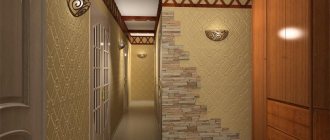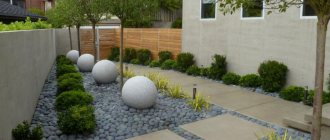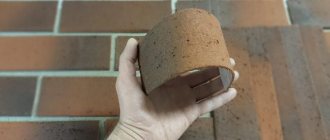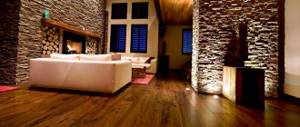Advantages of finishing openings with stone
Decorative stone allows you to imitate rough stonework, but at the same time looks natural and neat. It is used both for private houses and apartments.
Advantages of stone arches:
- attractive appearance;
- create a feeling of comfort;
- relative ease of installation;
- variety of options available;
- durability;
- reducing the load on the structure compared to natural stone;
- environmental friendliness and safety of the material.
…
Benefits of stone
Both artificial and natural stone are used for finishing. But not so long ago, the second option became less popular for the reasons that it is much more expensive and heavier. So, let's look at the benefits of artificial stone.
- A light weight. Using this stone there is no need to further strengthen the foundation and use an expensive adhesive layer;
- Long service life due to its moisture resistance, resistance to dust and dirt. Thanks to such qualities, the material can last for decades;
- The material is created on the basis of non-toxic substances, therefore completely environmentally friendly. Even though it is artificial, it is in no way inferior to natural materials;
- The price of the finishing material is pleasing. Considering the fact that the stone is produced on the basis of concrete, its price is not high;
- Installation is very simple and quick. To carry out installation, you do not need to purchase additional mounting fasteners and there is no need to hire craftsmen. Finishing a doorway with decorative stone can be done with your own hands;
- The range of material is simply amazing. Probably the big problem is the choice of material. There is no other finishing material with such an amount of texture and shades;
- Resistant to temperature changes. He is not afraid of indicators from –40 to +70 degrees. Having such abilities, decorative stone is very often used for cladding fireplaces and external surfaces of house walls.
Related article: DIY rabbit cages
Required materials and tools
If you decide to finish the slopes with decorative stone, you need to immediately choose the cladding, since the glue is selected depending on the density and weight of the product. It could be:
- gypsum;
- clinker;
- sandstone;
- concrete;
- polymer mixtures.
The lightest material is gypsum tiles. Please note that it is less durable and more susceptible to changes in humidity. Mandatory surface treatment (eg paint and varnish) is required.
…
To frame the front door and decorate the interior arch, you will need the same set of materials and tools. In addition to tiles and glue you will need:
- primer;
- putty;
- water repellent;
- putty knife;
- grout;
- construction syringe;
- airbrush (paint sprayer, pneumatic tool);
- level;
- wire cutters
Surface preparation
Before finishing the arch with decorative stone, it is necessary to prepare the surface. If the shape of the opening has not yet been completed or there are serious irregularities, all defects must be corrected.
First of all, it is necessary to draw clear contours of the arch. Drywall is used for this. All joints and corners must be sealed with plaster.
…
To ensure that the cladding adheres well, the surface is primed. For this purpose, deep penetration mixtures and a roller are used.
If the room is extremely damp, you need to apply an antiseptic to protect against fungus and mold.
Develop an approximate installation diagram. After the surface has dried, we transfer the contours of the finish from the sketch to the wall. Make 2-4 control marks. It’s better to start working from the bottom up, and if there are any unevenness, leave room at the bottom to correct them. At eye level, only solid and beautiful fragments are used.
Facing
The decorative stone is placed on the glue using a small spatula. It is important to distribute the solution evenly so that the layer is of the same thickness, without voids or sagging.
Choose the correct position for the element, according to the diagram, and press the stone against the wall. Carefully adjust its position and tap to remove any air bubbles. You need to work extremely carefully so as not to displace the tiles or break off pieces from them.
…
The scheme is chosen arbitrarily. In this way, it is possible to imitate natural, careless masonry.
There is no need to leave even cuts on the stone - the edges of the tiles are filed or processed with nippers.
Final processing
The final stage includes the following manipulations:
- Grout. To carefully fill the seams with mastic, use a construction syringe.
- Water repellent. When facing an entrance door or arches in rooms with unstable humidity levels, this stage of work is mandatory. A water repellent is sprayed on top of the stone. After drying, it protects the coating from penetration of moisture into its structure, but at the same time allows the wall to “breathe”.
- Decorative spraying. This is relevant if you use white gypsum tiles for cladding. Using an airbrush and colorant, you can change the shade of the coating. Water-based acrylic varnish is applied on top to protect the paint.
…
Thus, the new coating will take on a complete look and will be reliably protected from wear.
Stone selection
Given the great demand for the material, today there are several types of decorative stone:
- On concrete. This type consists of several materials and is considered the most common. For its production, cement, sand, reinforcing additives, dyes, and fillers are used.
- Porcelain tiles. Used mainly for interior wall decoration. It contains: clay, feldspar, minerals and coloring pigments. To create strength and stability, several types of clay are used to create it. As a result, this entire mixture is pressed and then fired. The opinion that porcelain stoneware is similar to stone is not true. Rather, it looks like glass rock with different colors. Its qualities are very high: it can withstand mechanical loads and temperature changes. It is not advisable to use it on a kitchen apron - it is very difficult to remove greasy stains from it.
- Conglomerates. It has high strength and reliability, and is very often used for finishing interior walls. It consists of marble and granite, limestone chips, sand and dyes. The appearance is very similar to natural agglomerate. It can also be used for exterior walls and has high strength and durability. Not afraid of frost and high temperatures. The relatively low weight allows you to carry out installation work yourself.
- Acrylic. This type of stone can be called the most practical. It is often used for interior wall decoration. Since it has excellent technical performance. Its structure allows it to withstand various mechanical loads, and it does not deform. Its surface can be cleaned with a clean rag without using additional detergents. Lightweight material that can be easily processed. It does not contain harmful substances, so it can be safely used for cladding bedrooms and children's rooms.
- Quartz. Finishing with quartz material is not particularly in demand, but it is impossible not to mention it. The stone has good characteristics: both resistance and durability. A diamond-coated disc is used to process it.
- Plaster. The most popular type, the demand for it is growing every year. Its light weight and rather attractive appearance make it a leader.
Related article: High temperature pipe insulation
Advantages of gypsum-based decorative stone:
- Moisture resistance. There is an opinion that this species is damaged by moisture. This is not true, it is treated with a special protective layer that prevents the penetration of moisture;
- Non-flammable, does not deform under load;
- Easy to install, light weight;
- The appearance resembles sandstone;
- You can make it yourself. To do this, you need to have plaster dough, molds, pigments for coloring and a lubricant.
To prepare it, you need to knead the gypsum dough, then add dyes. After this, pour into the molds. After waiting for complete hardening (24 hours), it must be carefully removed from the mold and lubricated with a moisture-resistant substance.
Photos of arches made of decorative stone
Decorating a doorway with artificial stone is a great way to fill your interior with style and a feeling of comfort.
Why choose this material?
Doorways are finished with moldings, stucco, plaster and other methods. But why should you choose decorative stone? What are its advantages? This is a lightweight and aesthetic material that is inexpensive. Its installation does not require much effort, and the variety of colors and textures of the stone sets the tone for the design of the room.
Choice of colors and textures of decorative products imitating stone
Advantages of the material:
- Does not affect the microclimate in the house, like natural stone.
- Has light weight.
- Does not burn.
- It does not absorb moisture, so this decorative element can also be used in rooms with high humidity.
- Durable, almost like natural stone.
- It is resistant to wear, so the appearance of the product remains unchanged for many years.
- Production is automated, resulting in smooth edges and easier installation.
- To decorate a wall surface with artificial stone, you do not need to be a professional.
- The product can be restored if the surface is damaged.
That's why it's worth decorating the interior of a room with decorative material.











